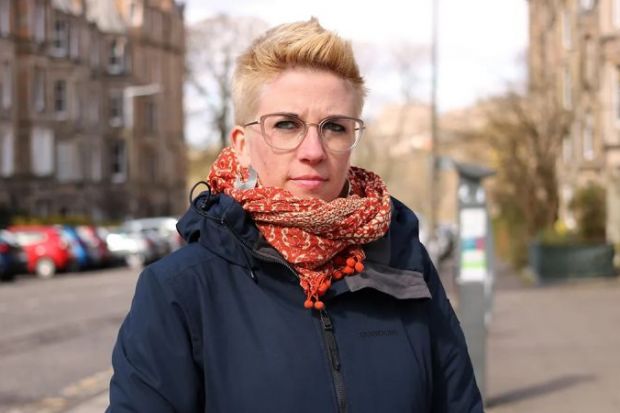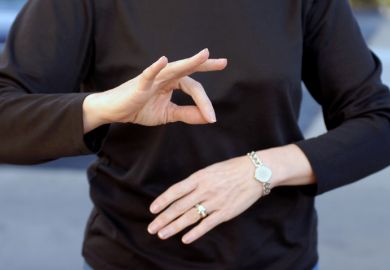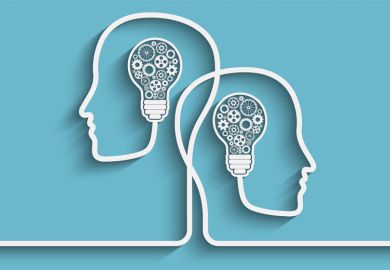The chance to study the only master’s degree in deaf studies that existed in Europe at the time brought Belgian academic Annelies Kusters to the UK in 2006.
Since then, her academic career has flourished and she has risen to become the country’s first deaf professor in deaf studies at Heriot-Watt University; an achievement she said felt “surreal” when she thought back to all the deaf scholars who supported her over the years, including those on that initial University of Bristol programme.
The master’s itself has not fared as well and was discontinued along with Bristol’s once leading Centre for Deaf Studies, which shut in 2013. The UK still does not have an equivalent programme to replace it.
Once a “beacon for deep exploration into deaf communities, cultures and languages”, the centre’s absence is still felt across the continent, according to Professor Kusters. Its decline showed the “fragility” of teaching and research in deaf studies, she said, “particularly as universities scrutinise and pare down their offerings”, a climate in which “small, specialised programmes are inherently vulnerable”.
Appointing a deaf professor in deaf studies was “overdue”, said Professor Kusters. Previously the only professors in the field – which first emerged in the late 1970s – had been hearing people.
The reasons for the delay were manifold, Professor Kusters said, and pointed to the wider difficulties of being deaf in academia.
Mainstream education systems had rarely catered for their learning needs, she said, which meant many deaf people had struggled with universities’ emphasis on writing skills. Higher positions had also tended to go to people who were not marginalised and did not require specialised services or accommodations, she added.
“The scarcity of high-level interpreters who can operate effectively within the academic realm is another barrier,” Professor Kusters said.
“The nuanced discourse of academia requires interpreters who are not only fluent in British Sign Language, but also possess a deep understanding of academic jargon, complex theories and the subtleties of higher-level networking. Such expertise is rare and can hinder the participation of deaf scholars in academic pursuits at the highest levels.”
But she also cautioned against the often-held preconception that providing access for deaf scholars inevitably involves hiring a sign language interpreter – instead, she said, universities should explore other ways to foster direct communication.
“Bringing in interpreters inherently changes the dynamics of discourse, from turn-taking to self-expression,” Professor Kusters said. “Deaf scholars are always locked in ‘asking or giving access’ dynamics. This is not conducive to creativity and intellectual stimulation.”
She cited her own experience as a postdoc in Germany where – during shared lunches and dinners – she and colleagues engaged in written networking exchanges, allowing her to participate in the informal, spontaneous “corridor talk” that so often shaped academic careers but from which deaf people were usually excluded.
Establishing spaces that are deaf-centric or sign-language-centric was also “not just beneficial but fundamental”, Professor Kusters said, but these remained “extremely rare” and efforts to create them were often met with resistance, especially if they required funding.
All deaf people would have different communication preferences, Professor Kusters said, and “there always is a tightrope to walk between creating all-signing spaces and giving non-signing audiences access to our discourses to allow mutually beneficial conversations and projects with non-signing scholars”.
But advancements in artificial intelligence and technology were expanding the possibilities for “ensuring mutual participation and understanding beyond what was imaginable a decade ago”, she argued.
AI’s continuing transformation of higher education also presented opportunities on the research side, she said, because “deaf scientists have much to offer to the development of AI solutions”.
Academia had always traditionally relied on spoken language and the written word, but deaf perspectives – grounded in the unique syntax, pragmatics and semantics that sign languages create – could “challenge and expand conventional understandings of the human experience”, said Professor Kusters, whose own research on the practices of deaf communities around the world utilises film and other visual methods.
This is why she believes it is vital that more deaf scholars advance to senior academic positions and be supported to explore interests and research beyond the sign language programmes that employ the majority of deaf scholars at British universities currently.
Professor Kusters said a new generation was emerging, and initiatives such as the introduction of BSL courses at secondary school level might help to increase interest in the field in the years ahead.
But universities must also be proactive, and re-establishing an interdisciplinary master’s in deaf studies that brings together deaf students from various fields was a “must”, she said.
Register to continue
Why register?
- Registration is free and only takes a moment
- Once registered, you can read 3 articles a month
- Sign up for our newsletter
Subscribe
Or subscribe for unlimited access to:
- Unlimited access to news, views, insights & reviews
- Digital editions
- Digital access to THE’s university and college rankings analysis
Already registered or a current subscriber?








